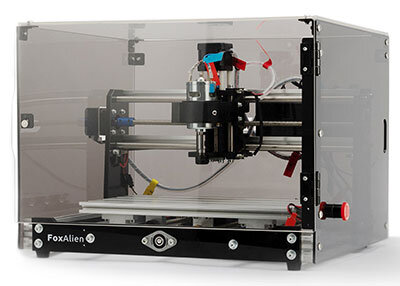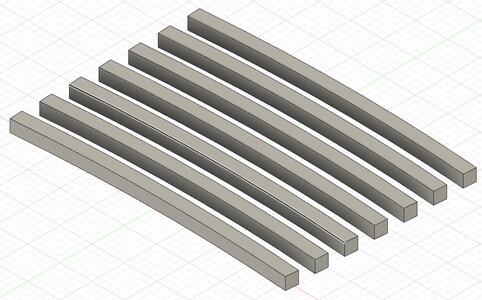- Joined
- May 26, 2021
- Messages
- 20
- Points
- 48

After doing a considerable amount of research and comparison between 3D Printers, Lasers, and CNC Routers for some time; weighing the pros and cons of each and how they would fit into a scratch builder's arsenal. Ultimately I decided on the Foxalien 3018-SE V2. With an Active Work Area of 278x157x 33mm/11"x6.18"x1.3" I believed this would provide me with sufficient height, width, and depth (X, Y, and Z) for nearly anything I wanted to create. At $319.00, it also fits nicely into the budget and would only require the family to subsist on fish heads and rice for approximately 2.37 weeks. (I have enough Soy and Duck Sauce packets stashed away for them in the fridge.)
The unit arrived the day after ordering (Don't ya just love Amazon Prime), well packed and without having been dragged down the street by the delivery service. Assembly was dead simple as the assemble manual consisted almost entirely of well-annotated pictures. The initial operation took a bit of patience and thought, not because it was complicated in any way but that it was necessary to get my head wrapped around a new way of thinking. However, thanks to some very well documented FAQs on the manufacturer's website, and top-notch customer service on the part of Foxalien (Answers within 24 hours), and a few test files provided on a flash drive, I very quickly produced my first CNC Engraving - The manufacturer's logo.
Next, it was on to learn the application necessary to produce the variety of ship parts that this fine machine would produce. In this case, it was the recommended AutoDesk Fusion 360. The desktop application is Free with a few limitations - none that would be a hindrance for my purposes. Having used programs such as QCad and SketchUp in the past, launching Fusion 360 was not like entering a completely alien world. With the help of a tremendous multitude of Fusion 360 Tutorials on YouTube, within three days I was producing beams, ledgers, gratings, and of course the obligatory wife's first name. The results were far better than I expected.
It is certainly safe to say that material selection is the key to producing accurate, high-quality, ship parts. Open-grained woods will naturally produce "fuzzy" carvings but this can be somewhat overcome with the right end mill selection. My most successful use of the machine thus far is grating made of Boxwood.
All in all, I am extremely happy with my choice of a CNC Router. Relatively fast and extremely accurate, I have no worries when it comes to filament type (3D Printer) or scorching (Laser). I can also produce intricate 2.5D carvings with little fuss. An added bonus, one that I did not realize when purchasing the machine, is that it can easily be fitted with a Laser which gives me two machines for the price of one. I'm unsure if I will ever need/want those capabilities, but it is still nice to have.
All-in-all I'm very pleased with my purchase and would certainly recommend this method and machine to anyone interested in taking the dive. If there are others out there who are using this or a similar CNC Router, I would love to hear from you. Perhaps we can exchange ideas, lessons learned, or even carving files.
Sincerely,
Hank
The unit arrived the day after ordering (Don't ya just love Amazon Prime), well packed and without having been dragged down the street by the delivery service. Assembly was dead simple as the assemble manual consisted almost entirely of well-annotated pictures. The initial operation took a bit of patience and thought, not because it was complicated in any way but that it was necessary to get my head wrapped around a new way of thinking. However, thanks to some very well documented FAQs on the manufacturer's website, and top-notch customer service on the part of Foxalien (Answers within 24 hours), and a few test files provided on a flash drive, I very quickly produced my first CNC Engraving - The manufacturer's logo.
Next, it was on to learn the application necessary to produce the variety of ship parts that this fine machine would produce. In this case, it was the recommended AutoDesk Fusion 360. The desktop application is Free with a few limitations - none that would be a hindrance for my purposes. Having used programs such as QCad and SketchUp in the past, launching Fusion 360 was not like entering a completely alien world. With the help of a tremendous multitude of Fusion 360 Tutorials on YouTube, within three days I was producing beams, ledgers, gratings, and of course the obligatory wife's first name. The results were far better than I expected.
It is certainly safe to say that material selection is the key to producing accurate, high-quality, ship parts. Open-grained woods will naturally produce "fuzzy" carvings but this can be somewhat overcome with the right end mill selection. My most successful use of the machine thus far is grating made of Boxwood.
All in all, I am extremely happy with my choice of a CNC Router. Relatively fast and extremely accurate, I have no worries when it comes to filament type (3D Printer) or scorching (Laser). I can also produce intricate 2.5D carvings with little fuss. An added bonus, one that I did not realize when purchasing the machine, is that it can easily be fitted with a Laser which gives me two machines for the price of one. I'm unsure if I will ever need/want those capabilities, but it is still nice to have.
All-in-all I'm very pleased with my purchase and would certainly recommend this method and machine to anyone interested in taking the dive. If there are others out there who are using this or a similar CNC Router, I would love to hear from you. Perhaps we can exchange ideas, lessons learned, or even carving files.
Sincerely,
Hank
Last edited:






 3018 SE v2. I did my "due diligence" and bought an "entry-level," yet capable machine for my needs. I have no intention of venturing into any work larger than 300mm x 180mm x 45mm (11.8in x 7in x 1.75in). Larger machines are great for those who plan to adopt CNC Routers as a revenue stream. The very last thing I want to have is a "Job."
3018 SE v2. I did my "due diligence" and bought an "entry-level," yet capable machine for my needs. I have no intention of venturing into any work larger than 300mm x 180mm x 45mm (11.8in x 7in x 1.75in). Larger machines are great for those who plan to adopt CNC Routers as a revenue stream. The very last thing I want to have is a "Job."